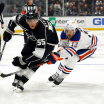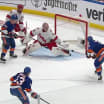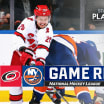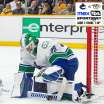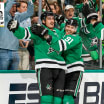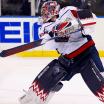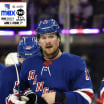Goaltending plays an integral part in the Stanley Cup Playoffs so NHL.com is breaking down the battle between the pipes in each series this season, charting goals to find strengths, weaknesses and targetable tendencies.
The St. Louis Blues and Dallas Stars relied on a goaltending tandem in the regular season, but while the Stars continued to switch back and forth between Kari Lehtonen and Antti Niemi during their Western Conference First Round victory against the Minnesota Wild, the Blues stuck with Brian Elliott against the Chicago Blackhawks.
Elliott, Lehtonen, Niemi have share of pros, cons
Close call between Blues starter, Stars tandem in Western Conference Second Round

By
Kevin Woodley
NHL.com Independent Correspondent
Elliott finished off the Blackhawks' attempt to come back from a 3-1 series deficit with 31 saves in a 3-2 victory in Game 7, and finished the first round with a .929 save percentage, just shy of his NHL-leading .930 in 38 regular-season starts. He will need to keep it up, but Elliott won't be the only goaltender facing questions in this series.
Lehtonen and Niemi each struggled at times in the first round, including almost blowing a 4-0 lead in their series-clinching win, but given the defensive breakdowns in front, most expect Lehtonen to be back in the net to start the second round. The big question is if - or how long it will be before - the Stars need Niemi again, and whether the style differences between the two is enough to throw Blues shooters off.
POSITIONING: Elliott plays deeper, getting his heels past the top of his crease against rush plays, but mostly plays in his crease, prioritizing early angle over depth with short, quick inside-out movements that make it easy for him to stay in the middle of the net and square the shooter. Elliott will take more ice quickly when he reads an open shot, but it's an inside-out approach that starts back in the crease, which can leave him exposed high on shots from the slot, something the Blues surrendered a lot of in Games 1, 4 and 6 against the Blackhawks, especially if he doesn't stay patient on his skates and reactive with his hands.
Lehtonen is at his best when he isn't overaggressive with his initial positioning, an ongoing quest that continued with Stars goaltending coach Jeff Reese this season. The bigger change this season may be in Niemi's approach, which evolved away from his inside-out roots with the Blackhawks to include a lot more backward flow with the San Jose Sharks. He's back to playing predominantly inside the crease now, beating rush plays by establishing early angle rather than trying to time his retreats to them, but the lack of backward flow left him stranded and reaching on a couple breakaway goals against the Wild.
Advantage: Because even though he chased the play a few times in the first round, he tends to be more consistent in his approach, Elliott.
BLOCK/REACT THRESHOLD: Elliott's positioning and size leave him little choice but to stay active with his hands, including using an active stick to cut off passing lanes through his crease and throw out the odd poke check. He holds his glove up above his shoulder, which helps take away the top corner, but the Blackhawks handcuffed him with mid-net glove shots that led to three clean-shot goals in the first round.
Lehtonen also has active hands, and like fellow Finn Pekka Rinne of the Nashville Predators, will scoop pucks in front of his pads to prevent rebounds. He does tend to reach, though, chasing shots headed wide, which delays his ability to get to his next position and can leave him stranded. Niemi always has reacted up and out with his hands, but does so effectively, especially now that he's set and ready more often.
Advantage:Because his positioning wouldn't work without active hands,Elliott.
PUCKHANDLING:Lehtonen has three assists this season and Niemi has two. Though it may just be a function of leaving pucks behind the net to start the high-scoring Stars' transition, at least they're getting touches, which is more than Elliott usually does. Blues coach Ken Hitchcock admits his defense plays differently when Jake Allen is in net because of his ability to handle the puck and start the transition.
Advantage: Because it's not hard to have an edge here, either Stars goalie.
POST PLAY:Sealing the post and handling plays from below the goal line wasn't a strength for either team in the first round.
Lehtonen can seal the ice from post to post without moving, but tends to stay on his knees even as the play moves up the zone and isn't always crisp coming off his posts, especially when he goes into them with his pad inside the net. Niemi is no longer putting his skate outside the post when using traditional VH, with the lead pad up against the post, a move other teams were targeting with backdoor plays in San Jose because of the inherent delays getting across. But he does put his shortside pad inside the post in reverse-VH, which improves the seal but creates slight delays getting off the post.
Elliott appears to have a nice balance between staying on his skates and using the reverse-VH as a save selection, rather than deferring to it anytime a puck is near or below the goal line. But the Blackhawks caught him leaving the short-side post early on plays behind the net several times, leading to two goals in the series and one fortunate no-look blocker save in Game 7, and his skate-on-post execution of reverse-VH left a short-side gap Chicago also managed to find for a couple of goals.
Advantage: Lehtonen and Niemi aren't always pretty on their posts, but because Elliott was beaten on six sharp-angle or low-high plays that started behind the net in the first round, the Stars goalies.
SCORING TRENDS:The low-high pass outs from behind the net clearly were a target against on Elliott by the end of the first round, but the other trend that emerged involved traffic and a tendency to shrink back behind it. Because he relies so much on active hands to make up for that depth, traffic becomes even more important against Elliott, who was beaten four times in the first three games on high shots with screens and deflections. He also can get caught outside his posts as rushes get low and wide, leaving him more exposed to rebound off the far-side pad and passes into the middle, but the Blues defend both well.
It was easier to find exploitable tendencies on Niemi last season with all the extra movement, especially off the rush, but he is playing a more neutral game in Dallas. Lehtonen still has a habit of chasing pucks with reaching hands, and despite narrowing his stance on end-zone play can still get spread out low and wide off the rush and on walk outs, but he isn't getting stranded as often with his positioning now.
Advantage: Because Chicago found a couple key exploitable habits, Lehtonen and Niemi.
